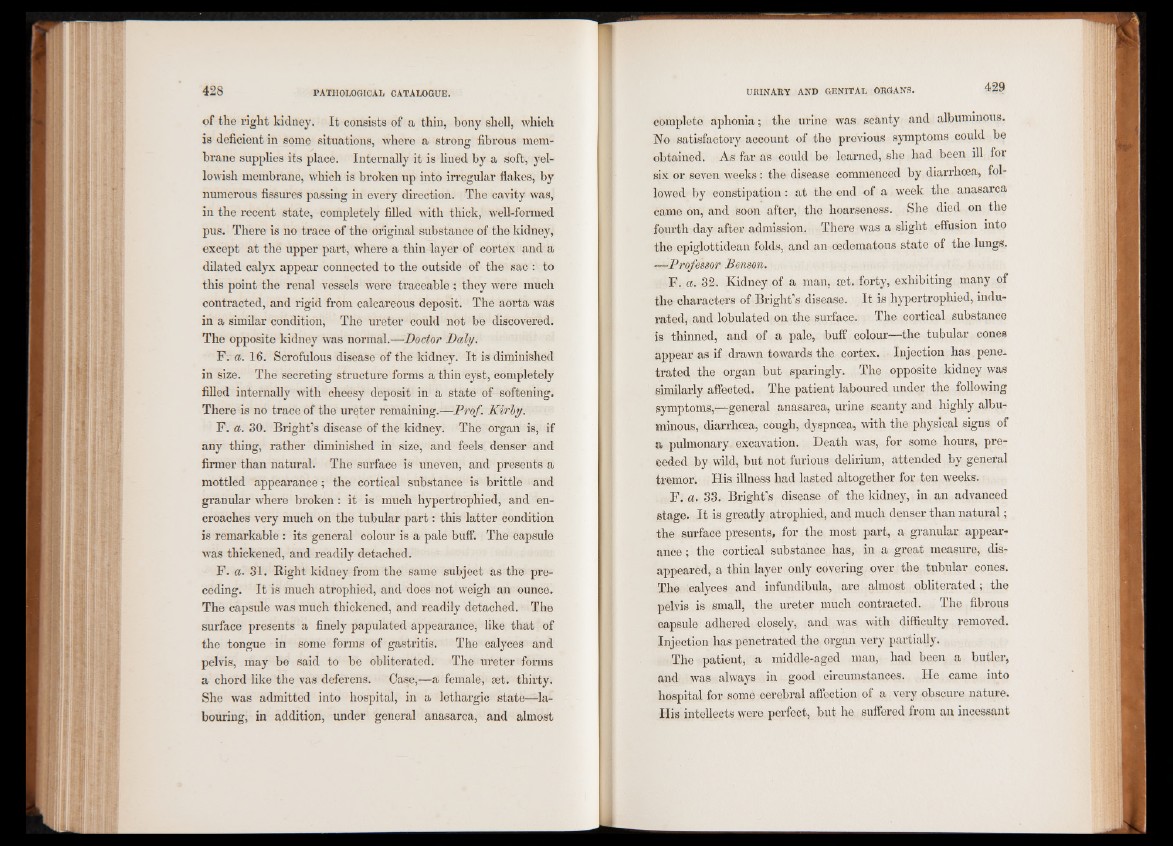
of the right kidney. It consists of a thin, bony shell, which
is deficient in some situations, where a strong fibrous membrane
supplies its place. Internally it is lined by a soft, yellowish
membrane, which is broken up into irregular flakes, by
numerous fissures passing in every direction. The cavity was,
in the recent state, completely filled with thick, well-formed
pus. There is no trace of the original substance of the kidney,
except at the upper part, where a thin layer of cortex and a
dilated calyx appear connected to the outside of the sac : to
this point the renal vessels were traceable ; they were much
contracted, and rigid from calcareous deposit. The aorta was
in a similar condition, The ureter could not be discovered.
The opposite kidney was normal.—Doctor Daly.
F. a. 16. Scrofulous disease of the kidney. It is diminished
in size. The secreting structure forms a thin cyst, completely
filled internally with cheesy deposit in a state of softening.
There is no trace of the ureter remaining.—Prof. Kirby.
F. a. 30. Bright’s disease of the kidney. The organ is, if
any thing, rather diminished in size, and feels denser and
firmer than natural. The surface is uneven, and presents a
mottled appearance; the cortical substance is brittle and
granular where broken: it is much hypertrophied, and encroaches
very much on the tubular part: this latter condition
is remarkable : its general colour is a pale buff. The capsule
■ was thickened, and readily detached.
F. a. 31. Right kidney from the same subject as the preceding.
It is much atrophied, and does not weigh an ounce.
The capsule was much thickened, and readily detached. The
surface presents a finely papulated appearance, like that of
the tongue in some forms of gastritis. The calyces and
pelvis, may be said to be obliterated. The ureter forms
a chord like the vas deferens. Case,—a female, set. thirty.
She was admitted into hospital, in a lethargic state—labouring,
in addition, under general anasarca, and almost
complete aphonia; the urine was scanty and albuminous.
No satisfactory account of the previous symptoms could be
obtained. As far as could be learned, she had been ill for
six or seven weeks: the disease commenced by diarrhoea, followed
by constipation: at the end of a week the anasarca
came on, and soon after, the hoarseness. She died on the
fourth day after admission. There was a slight effusion into
the epiglottidean folds, and an oedematous state of the lungs.
—Professor Benson.
F. a. 32. Kidney of a man, mt. forty, exhibiting many of
the characters of Bright’s disease. It is hypertrophied, indurated,
and lobulated on the surface. The cortical substance
is thinned, and of a pale, buff colour—the tubular cones
appear as if drawn towards the cortex. Injection has penetrated
the organ but sparingly. The opposite kidney was
similarly affected. The patient laboured under the following
symptoms,—general anasarca, urine scanty and highly albuminous,
diarrhoea, cough, dyspnoea, with the physical signs of
a pulmonary excavation. Death was, for some hours, preceded
by wild, but not furious delirium, attended by general
tremor. His illness had lasted altogether for ten weeks.
F. a. 33. Bright’s disease of the kidney, in an advanced
stage. It is greatly atrophied, and much denser than natural;
the surface presents, for the most part, a granular appearance
; the cortical substance has, in a great measure, disappeared,
a thin layer only covering over the tubular cones.
The calyces and infundibula, are almost obliterated; the
pelvis is small, the ureter much contracted. The fibrous
capsule adhered closely, and was with difficulty removed.
Injection has penetrated the organ very partially.
The patient, a middle-aged man, had been a butler,
and was always in good circumstances. He came into
hospital for some cerebral affection of a very obscure nature.
His intellects were perfect, but he suffered from an incessant